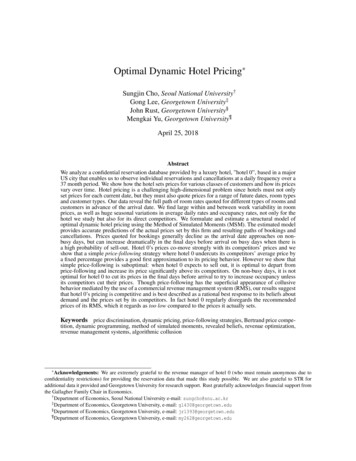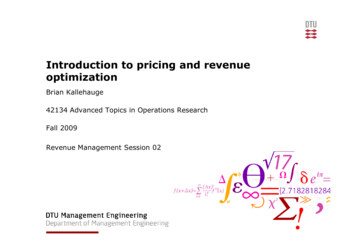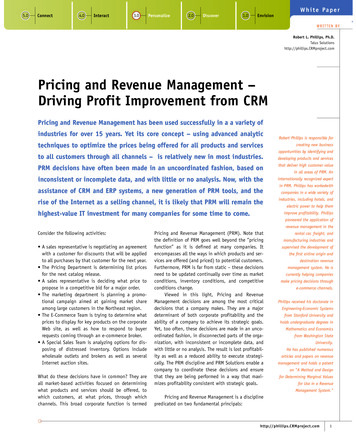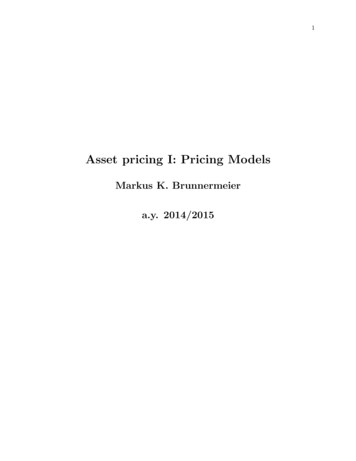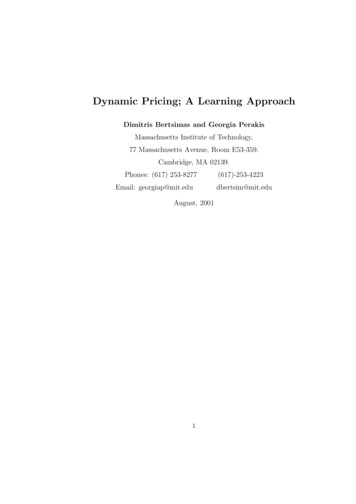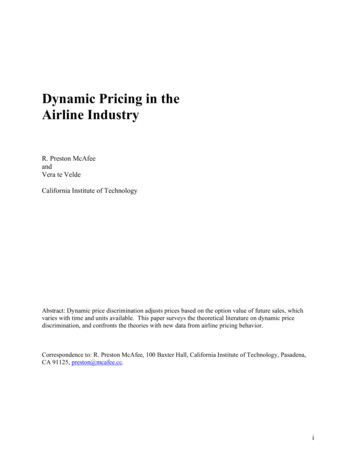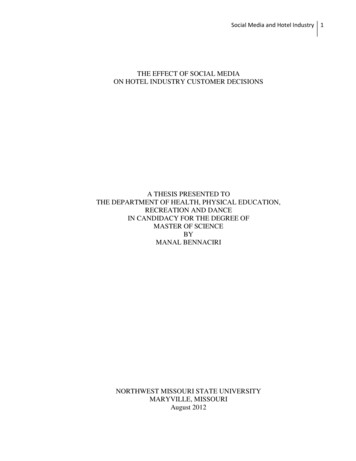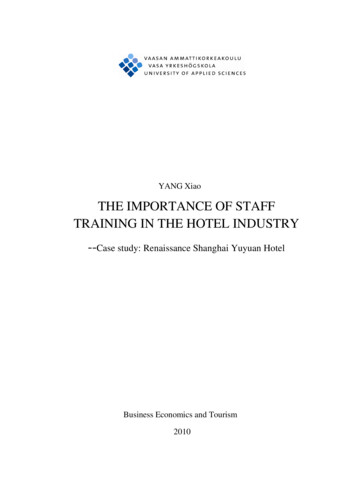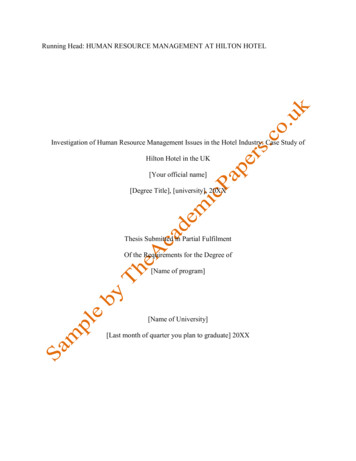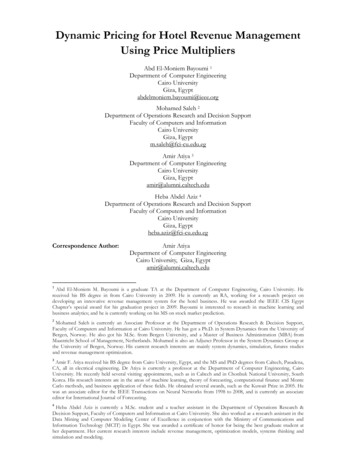
Transcription
Dynamic Pricing for Hotel Revenue ManagementUsing Price MultipliersAbd El-Moniem Bayoumi 1Department of Computer EngineeringCairo UniversityGiza, Egyptabdelmoniem.bayoumi@ieee.orgMohamed Saleh 2Department of Operations Research and Decision SupportFaculty of Computers and InformationCairo UniversityGiza, Egyptm.saleh@fci-cu.edu.egAmir Atiya 3Department of Computer EngineeringCairo UniversityGiza, Egyptamir@alumni.caltech.eduHeba Abdel Aziz 4Department of Operations Research and Decision SupportFaculty of Computers and InformationCairo UniversityGiza, Egyptheba.aziz@fci-cu.edu.egCorrespondence Author:Amir AtiyaDepartment of Computer EngineeringCairo University, Giza, Egyptamir@alumni.caltech.edu1Abd El-Moniem M. Bayoumi is a graduate TA at the Department of Computer Engineering, Cairo University. Hereceived his BS degree in from Cairo University in 2009. He is currently an RA, working for a research project ondeveloping an innovative revenue management system for the hotel business. He was awarded the IEEE CIS EgyptChapter’s special award for his graduation project in 2009. Bayoumi is interested to research in machine learning andbusiness analytics; and he is currently working on his MS on stock market prediction.2Mohamed Saleh is currently an Associate Professor at the Department of Operations Research & Decision Support,Faculty of Computers and Information at Cairo University. He has got a Ph.D. in System Dynamics from the University ofBergen, Norway. He also got his M.Sc. from Bergen University, and a Master of Business Administration (MBA) fromMaastricht School of Management, Netherlands. Mohamed is also an Adjunct Professor in the System Dynamics Group atthe University of Bergen, Norway. His current research interests are mainly system dynamics, simulation, futures studiesand revenue management optimization.3Amir F. Atiya received his BS degree from Cairo University, Egypt, and the MS and PhD degrees from Caltech, Pasadena,CA, all in electrical engineering. Dr Atiya is currently a professor at the Department of Computer Engineering, CairoUniversity. He recently held several visiting appointments, such as in Caltech and in Chonbuk National University, SouthKorea. His research interests are in the areas of machine learning, theory of forecasting, computational finance and MonteCarlo methods, and business application of these fields. He obtained several awards, such as the Kuwait Prize in 2005. Hewas an associate editor for the IEEE Transactions on Neural Networks from 1998 to 2008, and is currently an associateeditor for International Journal of Forecasting.4Heba Abdel Aziz is currently a M.Sc. student and a teacher assistant in the Department of Operations Research &Decision Support, Faculty of Computers and Information at Cairo University. She also worked as a research assistant in theData Mining and Computer Modeling Center of Excellence in conjunction with the Ministry of Communications andInformation Technology (MCIT) in Egypt. She was awarded a certificate of honor for being the best graduate student ather department. Her current research interests include revenue management, optimization models, systems thinking andsimulation and modeling.
Dynamic Pricing for Hotel Revenue ManagementUsing Price Multipliers1 AbstractIn this paper we propose a new dynamic pricing approach for the hotel revenuemanagement problem. The proposed approach is based on having “price multipliers” thatvary around “1” and provide a varying discount/premium over some seasonal referenceprice. The price multipliers are a function of certain influencing variables (for example hoteloccupancy, time till arrival, etc). We apply an optimization algorithm for determining theparameters of these multipliers, the goal being to maximize the revenue, taking into accountcurrent demand, and the demand-price sensitivity of the hotel’s guest. The optimizationalgorithm makes use of a Monte Carlo simulator that simulates all the hotel’s processes, suchas reservations arrivals, cancellations, duration of stay, no shows, group reservations,seasonality, trend, etc, as faithfully as possible. We have tested the proposed approach bysuccessfully applying it to the revenue management problem of Plaza Hotel, Alexandria,Egypt, as a case study.Keywords: Revenue management system, dynamic pricing, price elasticity, Monte Carlo simulation, hotelroom forecasting.2 IntroductionRevenue management is the science of managing a limited amount of supply to maximizerevenue, by dynamically controlling the price/quantity offered. Revenue managementsystems have recently gained significant worldwide adoption in the hotel industry, at least forhigher-rated hotels. The typical hotel guest has probably noticed in the past few years aprogressively evolving level of the dynamism in the quoted room prices. This is indicative ofthe sophisticated nature of the algorithms behind these reservation systems. However, thehotel revenue management models are still in their infancy, and there is a need for furtherdevelopment and improvement of these systems. By the sheer number of worldwide hotelsevery percent of revenue improvement will add up considerably for the top line and muchmore so for the bottom line because of the thin margins in this industry.2
Hotel revenue systems can be partitioned into two major groups (Abdel aziz et al., 2011;Ingold et al., 2000; Talluri and Van Ryzin, 2005). In the first group, the quantity controlapproach, the rooms are segmented by categories, such as by rate, guest type, room type,and/or length of stay. Each category has a fixed price, but the number of rooms allocated tothe category is dynamically controlled in a way that maximizes revenue. The other group, thedynamic pricing approach, groups all similar rooms in one category, and applies a price thatis continually adjusted with time based on the supply and demand variations. The dynamicprice is set so as to maximize revenue, taking into account the hotel occupancy, and thecurrent and expected demand. The dynamic pricing approach is particularly prevalent insome online hotel reservations. The online nature makes updating the price periodically quitemanageable. So, it is expected that the dynamic pricing approach will in the future overcomethe quantity based approach in adoption.In this paper we propose a novel dynamic pricing approach. It is based on having a seasonalreference price, and control variables in the form of multipliers. Each multiplier will adjustthe price up or down around the reference price based on a certain influencing variables (forexample hotel occupancy, time till arrival, etc). The parameters of these multipliers areoptimized. The goal is to maximize the revenue, taking into account current demand, andthe demand-price sensitivity of the hotel’s guest. Embedded in the optimization model is aMonte Carlo simulation that simulates all the hotel’s processes, such as reservations arrivals,cancellations, duration of stay, no shows, group reservations, seasonality, trend, etc, asfaithfully as possible.The proposed dynamic pricing model has the advantage of framing the price in terms ofcarefully optimized premiums and discounts over a time varying or seasonal reference priceset by the hotel. This could conquer some of the hurdles that make some mid-range hotelsreluctant in adopting revenue management systems. The black-box behavior of some of theother models can at some times be unsettling. Our proposed model allows the hotel managerto give his input that he gained through his long experience. Moreover, this will reduce theuncertainty of where to expect the price, and hence improve the willingness of managers toadopt it.The rest of the paper is organized as follows. Section 3 presents a review of the literature.Section 4 discusses our proposed revenue management framework. A case study is presentedin Section 5. In Section 5 we present a conclusion.3
3 Literature ReviewA large volume of revenue management research has focused on the capacity controlapproach, especially in the earlier times (see McGill and van Ryzin (1999), McGill (1989),and Talluri and Van Ryzin (2005) for very valuable reviews of this approach, and Pullmanand Rodgers (2010) for a review of capacity management approaches in the hospitalityindustry). The dynamic pricing approach of revenue management, on which we focus in thisreview, has recently had its share of research. For example, Feng and Xiao (2000) present adynamic pricing model, where prices are selected from a set of predetermined prices overtime. Zhao and Zheng (2000) present a dynamic pricing model for selling a stock of aperishable product, where the demand is stochastic and it follows a non-homogeneousPoisson process. Gallego and Van Ryzin (1994) investigate the problem of pricing aperishable stock of items. They find an upper bound for general demand. Finally, theyextend their results by modeling the demand as a compound Poisson process. Perakis andSood (2004) present a model for the multi-period pricing problem, in order to maximize therevenue of perishable products in a competitive market, where the multiple periods couldcorrespond to duration of stay in the case of hotels. They assume that the demand is adeterministic function of the prices set by all sellers in that period. Chatwin (2000)introduces a dynamic pricing policy for perishable products. The price is also selected from apredetermined set of discrete prices. Moreover, the author assumes that the demand of theproduct follows a Poisson distribution with a rate that has some inverse relationship with theprice. It is common in the literature to assume Poisson arrivals for the product demand. Thisis a sensible assumption because of the successive arrival of independent events. The rate ofarrival, however, can be time varying, to reflect varying demand periods. Akçay et al. (2010)present a general stochastic dynamic programming pricing model for multi-productproblems. They introduce a linear utility framework for modeling the customer’s choice.The majority of revenue management research targeted the airline problem or any generalperishable product. However, some research considered the application of revenuemanagement to the hotel industry. Ivanov and Zhechev (2011) present a literature review ofthe main concepts and methods of hotel revenue management. Also, the review of Vinod(2004) describes the details of the problem of hotel revenue management, gives somedefinitions and guidelines, and reviews some literature. In this paragraph we will present areview of some of the hotel revenue management work that is based on the capacity controlapproach. For example, Bitran and Mondschein (1995) develop a model, whereby customers’4
arrivals are modeled as a non-homogenous Poisson process. In order to have their model asgeneral as possible, they allow for multiple types of rooms and also allow for downgradingbetween these types. They also consider reservations for multiple nights. They utilize someheuristics when searching for the optimal solution, in order to reduce the computationaleffort. Bitran and Gilbert (1996) present a hotel room capacity control approach, wherebythe reservations’ arrivals are modeled as a Poisson process, while no-shows and cancellationsare drawn from binomial distributions. They also develop simple heuristics that perform wellin practice. Baker and Collier (1999) develop two algorithms that integrate overbooking withthe allocation decisions. They aim to produce a realistic hotel operating environmentthrough simulation, where the demand is modeled as a Poisson process. They test andcompare the performance of five heuristics-based solutions. They conclude that the simplerheuristics work as well as the more complex ones in many operating environments. Baker etal. (2002) develop a forecasting-allocation approach that explicitly takes into account thedependability between the demand for a service package and the group of service packagesavailable for sale. The demand is modeled using a gamma probability distribution. Choi andCho (2000) develop a probabilistic rule-based framework for controlling the capacity ofhotels. The goal is to provide guidance to hotel managers through a set of decision rules.They take competitors’ effects into account, and assume that customers’ arrivals follow atruncated Poisson distribution. Goldman et al. (2002) study decision rules for controlling thehotel’s capacity, whereby reservations of multiple day stays are taken into account. Also, theydeal with overlapping decision periods by optimizing with respect to the complete range ofopen target booking dates, instead of only a fixed set of booking days. In their approachthey model the booking requests’ arrivals by a non-homogeneous Poisson process. Koideand Ishii (2005) propose controlling the hotel’s capacity using discounts on earlyreservations. They take into account cancellations and overbooking. Lai and Ng (2005)propose a network optimization model to control hotel’s room capacity. This model capturesthe random nature of the demand using a stochastic programming framework. It takes intoaccount network structure of length of stay, cancellations, different pricing policies, earlycheck-outs, extended stays, and over-booking. El Gayar et al. (2011) present an integratedframework for hotel room revenue maximization. They address group reservations and useforecasted demand that models the hotel’s reservation process. Badinelli (2000) presents amodel, which mainly targets small hotels. It is based on a dynamic programming formulationof the problem, which allows for general demand patterns, and it gives a simple closed-form5
solution. Guadix et al. (2010) introduce a decision support system for maximizing hotels’revenue. It includes methods for demand forecasting that consider both individual andgroup reservations. Also, it integrates deterministic and stochastic mathematicalprogramming models for the decision p
Dynamic Pricing for Hotel Revenue Management Using Price Multipliers Abd El-Moniem Bayoumi 1 Department of Computer Engineering Cairo University Giza, Egypt abdelmoniem.bayoumi@ieee.org Mohamed Saleh 2 Department of Operations Research and Decision Support Faculty of Computers and Information Cairo University Giza, Egypt m.saleh@fci-cu.edu.eg Amir Atiya 3 Department of Computer
